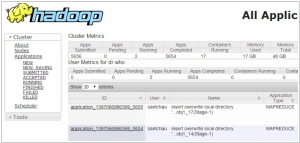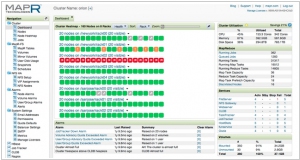Hadoop vs MapR
March 18, 2025 | Author: Michael Stromann
18★
The Apache Hadoop software library is a framework that allows for the distributed processing of large data sets across clusters of computers using simple programming models. It is designed to scale up from single servers to thousands of machines, each offering local computation and storage. Rather than rely on hardware to deliver high-availability, the library itself is designed to detect and handle failures at the application layer, so delivering a highly-available service on top of a cluster of computers, each of which may be prone to failures.
5★
The MapR Distribution for Apache Hadoop provides organizations with an enterprise-grade distributed data platform to reliably store and process big data. MapR packages a broad set of Apache open source ecosystem projects enabling batch, interactive, or real-time applications. The data platform and the projects are all tied together through an advanced management console to monitor and manage the entire system.
See also:
Top 10 Big Data platforms
Top 10 Big Data platforms
Big Data is a bit like the universe—vast, chaotic and full of things that might explode if you look at them the wrong way. Hadoop and MapR are both brave attempts to impose some kind of order on this madness, much like trying to organize a particularly rebellious library where the books keep rewriting themselves. They both let you store ridiculous amounts of data, process it at speeds that impress accountants but disappoint time travelers and integrate with enough analytics tools to make anyone feel like a wizard.
Hadoop, the elder statesman of this particular circus, has been around since 2006 and hails from the grand tradition of open-source software—meaning it's both free and frequently frustrating. It relies on a system called HDFS, which is quite good at storing things until the inevitable moment you realize the central node is down and all your important data is having a quiet existential crisis. It’s beloved by researchers, startups and anyone with more enthusiasm than budget, but if you need real-time magic or bulletproof reliability, you may find yourself looking elsewhere.
MapR, the upstart from 2009, took one look at Hadoop and said, "We can do better." It replaced the finicky HDFS with its own custom file system, got rid of the single point of failure nonsense and threw in some fancy NoSQL and streaming capabilities just for fun. Unlike Hadoop, it plays nicely with POSIX, meaning you can treat it like a normal file system rather than an arcane relic requiring constant sacrifices. It’s built for enterprises that don’t like downtime, real-time applications that need to react faster than a caffeinated squirrel and anyone who prefers their data solutions with fewer emergency meetings.
See also: Top 10 Big Data platforms
Hadoop, the elder statesman of this particular circus, has been around since 2006 and hails from the grand tradition of open-source software—meaning it's both free and frequently frustrating. It relies on a system called HDFS, which is quite good at storing things until the inevitable moment you realize the central node is down and all your important data is having a quiet existential crisis. It’s beloved by researchers, startups and anyone with more enthusiasm than budget, but if you need real-time magic or bulletproof reliability, you may find yourself looking elsewhere.
MapR, the upstart from 2009, took one look at Hadoop and said, "We can do better." It replaced the finicky HDFS with its own custom file system, got rid of the single point of failure nonsense and threw in some fancy NoSQL and streaming capabilities just for fun. Unlike Hadoop, it plays nicely with POSIX, meaning you can treat it like a normal file system rather than an arcane relic requiring constant sacrifices. It’s built for enterprises that don’t like downtime, real-time applications that need to react faster than a caffeinated squirrel and anyone who prefers their data solutions with fewer emergency meetings.
See also: Top 10 Big Data platforms





